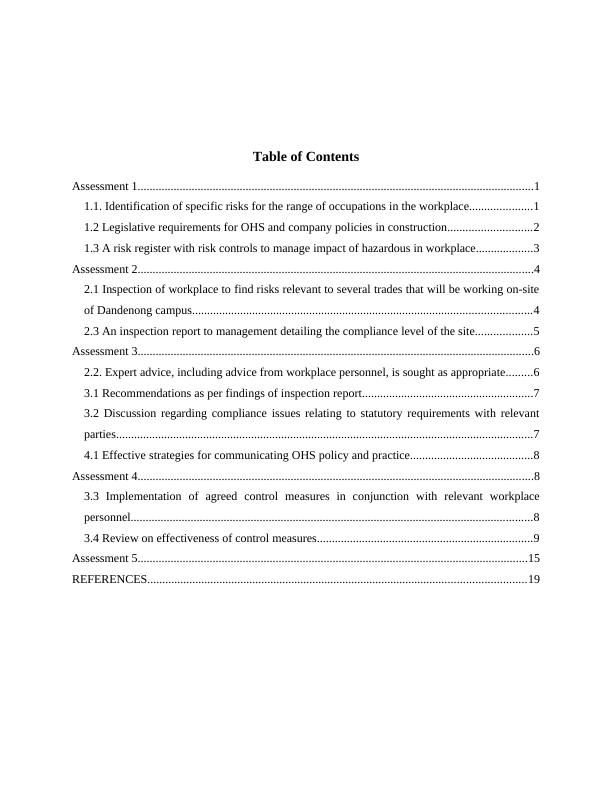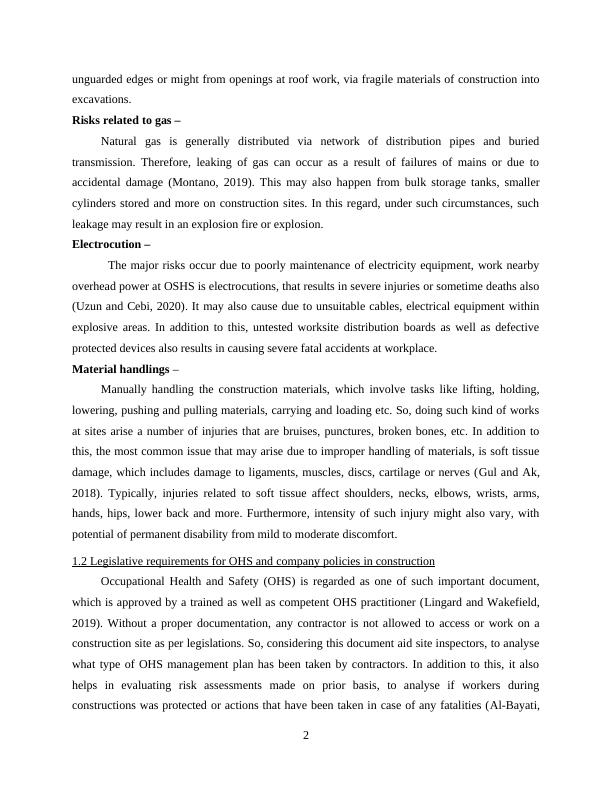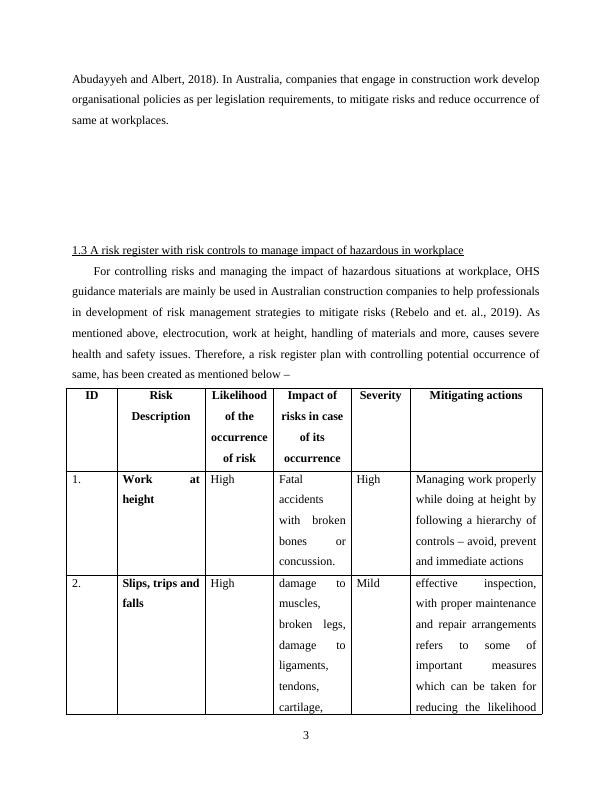Managing Occupational Health and Safety in the Building and Construction Workplace
Added on 2023-01-06
23 Pages6714 Words76 Views
Manage occupational health and safety
in the building and construction
workplace
in the building and construction
workplace

Table of Contents
Assessment 1....................................................................................................................................1
1.1. Identification of specific risks for the range of occupations in the workplace.....................1
1.2 Legislative requirements for OHS and company policies in construction............................2
1.3 A risk register with risk controls to manage impact of hazardous in workplace...................3
Assessment 2....................................................................................................................................4
2.1 Inspection of workplace to find risks relevant to several trades that will be working on-site
of Dandenong campus.................................................................................................................4
2.3 An inspection report to management detailing the compliance level of the site...................5
Assessment 3....................................................................................................................................6
2.2. Expert advice, including advice from workplace personnel, is sought as appropriate.........6
3.1 Recommendations as per findings of inspection report.........................................................7
3.2 Discussion regarding compliance issues relating to statutory requirements with relevant
parties...........................................................................................................................................7
4.1 Effective strategies for communicating OHS policy and practice.........................................8
Assessment 4....................................................................................................................................8
3.3 Implementation of agreed control measures in conjunction with relevant workplace
personnel......................................................................................................................................8
3.4 Review on effectiveness of control measures........................................................................9
Assessment 5..................................................................................................................................15
REFERENCES..............................................................................................................................19
Assessment 1....................................................................................................................................1
1.1. Identification of specific risks for the range of occupations in the workplace.....................1
1.2 Legislative requirements for OHS and company policies in construction............................2
1.3 A risk register with risk controls to manage impact of hazardous in workplace...................3
Assessment 2....................................................................................................................................4
2.1 Inspection of workplace to find risks relevant to several trades that will be working on-site
of Dandenong campus.................................................................................................................4
2.3 An inspection report to management detailing the compliance level of the site...................5
Assessment 3....................................................................................................................................6
2.2. Expert advice, including advice from workplace personnel, is sought as appropriate.........6
3.1 Recommendations as per findings of inspection report.........................................................7
3.2 Discussion regarding compliance issues relating to statutory requirements with relevant
parties...........................................................................................................................................7
4.1 Effective strategies for communicating OHS policy and practice.........................................8
Assessment 4....................................................................................................................................8
3.3 Implementation of agreed control measures in conjunction with relevant workplace
personnel......................................................................................................................................8
3.4 Review on effectiveness of control measures........................................................................9
Assessment 5..................................................................................................................................15
REFERENCES..............................................................................................................................19


Assessment 1
1.1. Identification of specific risks for the range of occupations in the workplace
Construction industry is considered as one of the high-risk industries, which has a
significant impact on occupational health & safety of workers. Although, it has seen that
construction labours and all associated workers mainly work at heights, with building and high
equipment materials (McLinton and et. al., 2018) (Bayram, 2018). So, such scenarios at sites, are
plagued potentially by dangerous situations as well as with poor working conditions. Workers
are highly exposed towards hazards which are difficult to quantify. In this regard, promote and
maintain safety within workplace, it is essential to obtain knowledge regarding with primary
causes of fatalities help in assessing the level of safety. But as there are number of job sites in
constructions that have different procedures or conditions, therefore, identifying source(s) which
poses challenges or risks to OHS of workforce remains critical (Gurmu, 2019). However, some
sources that arise risks at workplace includes tasks related with material handlings, unintended
collapses, asbestos, airborne fibres and toxins etc. Henceforth, contribution for implementing
safe working conditions, detection of risks that have greater potential to arise hazardous
conditions and fatalities with workers, when they encounter with the same is one of the main
responsibility of site inspector (Suarez, Carvajal and Catalá Alís, 2018). Some of risks arise at
construction are explained as below –
Slips, trips and falls
In any sector of organisations, range from heavy manufacturing companies to office
works, there is a high risk of slips, trips and falls. It creates serious consequences for the people
working there such as broken bones or other fatalities (Hassan and Esmail, 2018). Key causes of
slips, trips and consequences in construction includes obstacles, uneven surface, slippery or wet
surface, etc.
Work at height –
Falls from height is another main causes behind fatal accidents within construction
industries, where such risks can be characterised into two main types - fall of workers while
working from height; and fall of heavy objects on those workers who work on ground at most
construction sites (Quaigrain and Issa, 2018). Therefore, in both conditions, consequences are
considered as more severe greater when falling from height. Falls occur generally from the
1
1.1. Identification of specific risks for the range of occupations in the workplace
Construction industry is considered as one of the high-risk industries, which has a
significant impact on occupational health & safety of workers. Although, it has seen that
construction labours and all associated workers mainly work at heights, with building and high
equipment materials (McLinton and et. al., 2018) (Bayram, 2018). So, such scenarios at sites, are
plagued potentially by dangerous situations as well as with poor working conditions. Workers
are highly exposed towards hazards which are difficult to quantify. In this regard, promote and
maintain safety within workplace, it is essential to obtain knowledge regarding with primary
causes of fatalities help in assessing the level of safety. But as there are number of job sites in
constructions that have different procedures or conditions, therefore, identifying source(s) which
poses challenges or risks to OHS of workforce remains critical (Gurmu, 2019). However, some
sources that arise risks at workplace includes tasks related with material handlings, unintended
collapses, asbestos, airborne fibres and toxins etc. Henceforth, contribution for implementing
safe working conditions, detection of risks that have greater potential to arise hazardous
conditions and fatalities with workers, when they encounter with the same is one of the main
responsibility of site inspector (Suarez, Carvajal and Catalá Alís, 2018). Some of risks arise at
construction are explained as below –
Slips, trips and falls
In any sector of organisations, range from heavy manufacturing companies to office
works, there is a high risk of slips, trips and falls. It creates serious consequences for the people
working there such as broken bones or other fatalities (Hassan and Esmail, 2018). Key causes of
slips, trips and consequences in construction includes obstacles, uneven surface, slippery or wet
surface, etc.
Work at height –
Falls from height is another main causes behind fatal accidents within construction
industries, where such risks can be characterised into two main types - fall of workers while
working from height; and fall of heavy objects on those workers who work on ground at most
construction sites (Quaigrain and Issa, 2018). Therefore, in both conditions, consequences are
considered as more severe greater when falling from height. Falls occur generally from the
1

unguarded edges or might from openings at roof work, via fragile materials of construction into
excavations.
Risks related to gas –
Natural gas is generally distributed via network of distribution pipes and buried
transmission. Therefore, leaking of gas can occur as a result of failures of mains or due to
accidental damage (Montano, 2019). This may also happen from bulk storage tanks, smaller
cylinders stored and more on construction sites. In this regard, under such circumstances, such
leakage may result in an explosion fire or explosion.
Electrocution –
The major risks occur due to poorly maintenance of electricity equipment, work nearby
overhead power at OSHS is electrocutions, that results in severe injuries or sometime deaths also
(Uzun and Cebi, 2020). It may also cause due to unsuitable cables, electrical equipment within
explosive areas. In addition to this, untested worksite distribution boards as well as defective
protected devices also results in causing severe fatal accidents at workplace.
Material handlings –
Manually handling the construction materials, which involve tasks like lifting, holding,
lowering, pushing and pulling materials, carrying and loading etc. So, doing such kind of works
at sites arise a number of injuries that are bruises, punctures, broken bones, etc. In addition to
this, the most common issue that may arise due to improper handling of materials, is soft tissue
damage, which includes damage to ligaments, muscles, discs, cartilage or nerves (Gul and Ak,
2018). Typically, injuries related to soft tissue affect shoulders, necks, elbows, wrists, arms,
hands, hips, lower back and more. Furthermore, intensity of such injury might also vary, with
potential of permanent disability from mild to moderate discomfort.
1.2 Legislative requirements for OHS and company policies in construction
Occupational Health and Safety (OHS) is regarded as one of such important document,
which is approved by a trained as well as competent OHS practitioner (Lingard and Wakefield,
2019). Without a proper documentation, any contractor is not allowed to access or work on a
construction site as per legislations. So, considering this document aid site inspectors, to analyse
what type of OHS management plan has been taken by contractors. In addition to this, it also
helps in evaluating risk assessments made on prior basis, to analyse if workers during
constructions was protected or actions that have been taken in case of any fatalities (Al-Bayati,
2
excavations.
Risks related to gas –
Natural gas is generally distributed via network of distribution pipes and buried
transmission. Therefore, leaking of gas can occur as a result of failures of mains or due to
accidental damage (Montano, 2019). This may also happen from bulk storage tanks, smaller
cylinders stored and more on construction sites. In this regard, under such circumstances, such
leakage may result in an explosion fire or explosion.
Electrocution –
The major risks occur due to poorly maintenance of electricity equipment, work nearby
overhead power at OSHS is electrocutions, that results in severe injuries or sometime deaths also
(Uzun and Cebi, 2020). It may also cause due to unsuitable cables, electrical equipment within
explosive areas. In addition to this, untested worksite distribution boards as well as defective
protected devices also results in causing severe fatal accidents at workplace.
Material handlings –
Manually handling the construction materials, which involve tasks like lifting, holding,
lowering, pushing and pulling materials, carrying and loading etc. So, doing such kind of works
at sites arise a number of injuries that are bruises, punctures, broken bones, etc. In addition to
this, the most common issue that may arise due to improper handling of materials, is soft tissue
damage, which includes damage to ligaments, muscles, discs, cartilage or nerves (Gul and Ak,
2018). Typically, injuries related to soft tissue affect shoulders, necks, elbows, wrists, arms,
hands, hips, lower back and more. Furthermore, intensity of such injury might also vary, with
potential of permanent disability from mild to moderate discomfort.
1.2 Legislative requirements for OHS and company policies in construction
Occupational Health and Safety (OHS) is regarded as one of such important document,
which is approved by a trained as well as competent OHS practitioner (Lingard and Wakefield,
2019). Without a proper documentation, any contractor is not allowed to access or work on a
construction site as per legislations. So, considering this document aid site inspectors, to analyse
what type of OHS management plan has been taken by contractors. In addition to this, it also
helps in evaluating risk assessments made on prior basis, to analyse if workers during
constructions was protected or actions that have been taken in case of any fatalities (Al-Bayati,
2

Abudayyeh and Albert, 2018). In Australia, companies that engage in construction work develop
organisational policies as per legislation requirements, to mitigate risks and reduce occurrence of
same at workplaces.
1.3 A risk register with risk controls to manage impact of hazardous in workplace
For controlling risks and managing the impact of hazardous situations at workplace, OHS
guidance materials are mainly be used in Australian construction companies to help professionals
in development of risk management strategies to mitigate risks (Rebelo and et. al., 2019). As
mentioned above, electrocution, work at height, handling of materials and more, causes severe
health and safety issues. Therefore, a risk register plan with controlling potential occurrence of
same, has been created as mentioned below –
ID Risk
Description
Likelihood
of the
occurrence
of risk
Impact of
risks in case
of its
occurrence
Severity Mitigating actions
1. Work at
height
High Fatal
accidents
with broken
bones or
concussion.
High Managing work properly
while doing at height by
following a hierarchy of
controls – avoid, prevent
and immediate actions
2. Slips, trips and
falls
High damage to
muscles,
broken legs,
damage to
ligaments,
tendons,
cartilage,
Mild effective inspection,
with proper maintenance
and repair arrangements
refers to some of
important measures
which can be taken for
reducing the likelihood
3
organisational policies as per legislation requirements, to mitigate risks and reduce occurrence of
same at workplaces.
1.3 A risk register with risk controls to manage impact of hazardous in workplace
For controlling risks and managing the impact of hazardous situations at workplace, OHS
guidance materials are mainly be used in Australian construction companies to help professionals
in development of risk management strategies to mitigate risks (Rebelo and et. al., 2019). As
mentioned above, electrocution, work at height, handling of materials and more, causes severe
health and safety issues. Therefore, a risk register plan with controlling potential occurrence of
same, has been created as mentioned below –
ID Risk
Description
Likelihood
of the
occurrence
of risk
Impact of
risks in case
of its
occurrence
Severity Mitigating actions
1. Work at
height
High Fatal
accidents
with broken
bones or
concussion.
High Managing work properly
while doing at height by
following a hierarchy of
controls – avoid, prevent
and immediate actions
2. Slips, trips and
falls
High damage to
muscles,
broken legs,
damage to
ligaments,
tendons,
cartilage,
Mild effective inspection,
with proper maintenance
and repair arrangements
refers to some of
important measures
which can be taken for
reducing the likelihood
3

End of preview
Want to access all the pages? Upload your documents or become a member.
Related Documents
Role of Construction Manager in Promoting Health and Safety on Building Siteslg...
|10
|2556
|85
Analyzing the Health and Safety Risks in the Construction Site Assessment 2022lg...
|6
|913
|24
Recognition of Hazard in Workplace: Risk Management of Hazard Slippery Floorlg...
|26
|1213
|274
Manage Occupational Health and Safety Assessment 2022lg...
|25
|3602
|13
WHS Policies and Procedures for Workplace Safety: Hazards of Slips, Trips & Fallslg...
|13
|1827
|127
Risk Assessment Plan for the Eastman Chemical Companylg...
|17
|3571
|96
